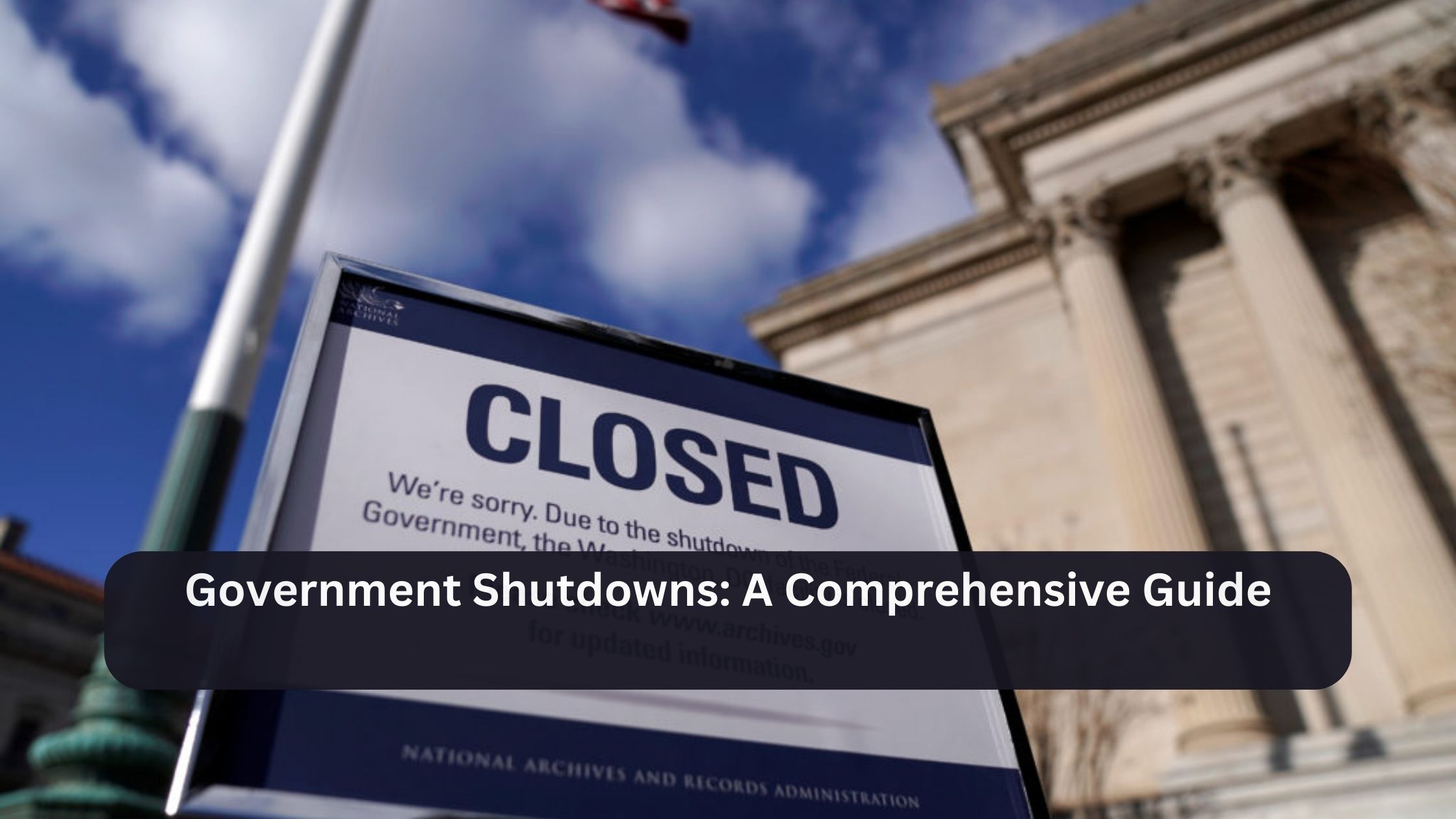A “government shutdown” occurs when the U.S. federal government temporarily suspends non-essential operations due to a lack of funding. This can happen when Congress fails to pass the necessary appropriations bills that allocate money to various government agencies. While the term might sound alarming, understanding the mechanics, causes, and impacts of a government shutdown can help demystify this complex process.
What is a Government Shutdown?
A government shutdown is essentially a pause in government operations. It happens when Congress does not approve the 12 annual appropriation bills required to fund the federal government. Without these appropriations, agencies do not have the legal authority to spend money, forcing them to cease non-essential functions.
Also Read: GDP – Deleted Scene – E355: An In-Depth Analysis
There are two main types of shutdowns:
- Full Government Shutdown: This occurs when none of the 12 appropriations bills are passed. All federal agencies, except those deemed essential, cease operations.
- Partial Government Shutdown: If Congress passes some but not all of the appropriation bills, only the agencies without approved funding are affected. This means that some parts of the government continue to operate while others do not.
The Mechanics of a Government Shutdown
When a shutdown is imminent, federal agencies begin to prepare by identifying which of their operations are essential and which are not. Essential services are those that protect life and property, such as law enforcement, air traffic control, and emergency medical care. These services continue to operate during a shutdown.
Non-essential services, on the other hand, are halted. This can include everything from national parks to passport processing. Federal employees who perform non-essential functions are furloughed, meaning they are put on temporary leave without pay.
Causes of Government Shutdowns
Government shutdowns typically occur due to political disagreements over the federal budget. These disagreements can arise from different priorities between political parties, debates over specific policies or programs, or disagreements on spending levels.
One common sticking point is discretionary spending, which includes funding for most federal agencies and programs. Discretionary spending is negotiated annually and can become a point of contention if parties cannot agree on how much to allocate.
Another potential cause is the debt ceiling. The debt ceiling is a cap set by Congress on how much the federal government is allowed to borrow. If the debt ceiling is not raised when needed, the government may run out of money to fund its operations, potentially leading to a shutdown.
Also Read: The Case for Marrying an Older Man: Why It Might Be Right for You
Historical Overview of Government Shutdowns
The United States has experienced several government shutdowns over the years, each with its unique circumstances and outcomes. Here are some notable examples:
- 1980 and 1981 Shutdowns: These early shutdowns were relatively short and primarily focused on funding issues for specific agencies.
- 1995-1996 Shutdowns: One of the longest shutdowns in U.S. history occurred during the Clinton administration, lasting 21 days. The shutdown stemmed from a budgetary dispute between President Bill Clinton and the Republican-controlled Congress over funding for Medicare, education, and the environment.
- 2013 Shutdown: This 16-day shutdown occurred due to disagreements over the Affordable Care Act (Obamacare). The impasse centered on Republican efforts to defund or delay the law’s implementation.
- 2018-2019 Shutdown: The longest shutdown in U.S. history lasted 35 days and was primarily about funding for a border wall proposed by President Donald Trump. The shutdown ended without the funding being approved, but a temporary agreement was reached to reopen the government.
The Impact of a Government Shutdown
Government shutdowns can have wide-ranging effects on both the federal government and the public. The impacts can vary depending on the length and scope of the shutdown, but some common effects include:
- Economic Impact: Shutdowns can slow economic growth as federal employees are furloughed, and contractors are not paid. This can lead to reduced consumer spending and affect businesses that rely on government contracts.
- Public Services: Many public services are disrupted during a shutdown. This can include delays in processing tax refunds, passport applications, and other government services. National parks and museums may also close, affecting tourism and local economies.
- Federal Employees: Hundreds of thousands of federal employees may be furloughed, leading to financial uncertainty. Essential workers may have to work without immediate pay, which can strain their personal finances.
- Government Operations: A shutdown can disrupt the planning and implementation of government programs and policies. This can lead to inefficiencies and delays in important projects and initiatives.
- Political Impact: Shutdowns often lead to public frustration and can affect the political landscape. They may influence public opinion of elected officials and can be a factor in future elections.
How to Prepare for a Government Shutdown
For individuals and businesses, preparing for a government shutdown involves understanding how it might affect you and taking steps to mitigate those impacts. Here are some tips:
- Federal Employees and Contractors: If you work for the federal government or are a contractor, consider setting aside savings to cover expenses during a furlough. Keep informed about the status of appropriations and be prepared for possible delays in pay.
- Businesses: If your business relies on government contracts or services, plan for potential disruptions. This might include diversifying your client base or creating contingency plans for delays in government payments.
- General Public: Be aware of the services that might be unavailable during a shutdown, such as national parks or certain public health programs. Plan accordingly if you have travel plans or need government services.
What Happens After a Government Shutdown?
Once a shutdown ends, federal agencies resume normal operations. Employees return to work, and furloughed workers typically receive back pay. However, the resumption of services can take time, and there may be a backlog of work to catch up on.
For the economy, the effects of a shutdown can linger. Businesses affected by the shutdown may take time to recover, and the overall economic impact can vary depending on the duration and severity of the shutdown.
Read More: The Flutterwave Scandal: A Comprehensive Analysis
FAQs About Government Shutdowns
Q1: What causes a government shutdown?
A: A government shutdown occurs when Congress fails to pass the 12 appropriation bills needed to fund federal agencies. This can happen due to political disagreements over the budget, specific policies, or spending levels.
Q2: Who is affected by a government shutdown?
A: A shutdown affects federal employees, government contractors, and the general public. Non-essential federal employees may be furloughed, and public services like national parks and passport processing may be suspended.
Q3: How long does a government shutdown last?
A: The duration of a government shutdown can vary. It can last from a few hours to several weeks, depending on how long it takes for Congress to reach an agreement on funding.
Q4: What happens to federal employees during a shutdown?
A: Federal employees performing non-essential functions are furloughed, meaning they are temporarily placed on leave without pay. Essential employees may continue working but may not receive immediate pay.
Q5: How can I prepare for a government shutdown?
A: Individuals and businesses can prepare by saving money, understanding which services may be affected, and making contingency plans for any disruptions.
Conclusion
A government shutdown is a complex and often disruptive event that can affect many aspects of public life and the economy. Understanding the causes, mechanics, and impacts of a shutdown can help individuals and businesses better prepare and respond. While the political landscape can make shutdowns seem unpredictable, staying informed and proactive can mitigate some of the challenges they pose.
Also Read: Dollar tree family dollar stores closing: Analysis!



